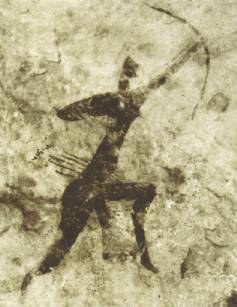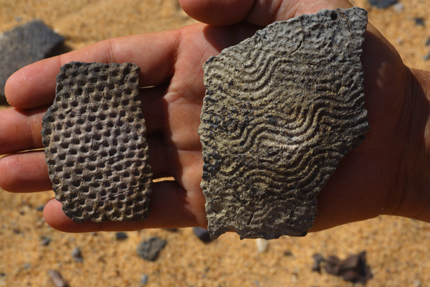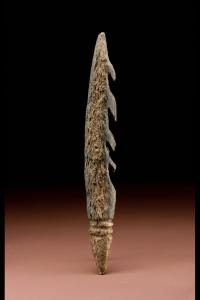
The IAM people [Early Neolithic Moroccans] (5), were nothing more than hunter-gatherer Kushites that had originally belonged to the Ounanian Culture (3-4). The Ounanians, like their Kushite descendants were great archers and based their civilization on hunting using the bow, and limited cattle domestication (3-4).
The Ounanian culture was first described by Breuil in 1930 at Ounan to the south of Taodeni in northern Mali. Ounanian Points are suggested to be the hallmark of the some Epipaleolithic industries in the central Sahara, the Sahel and northern Sudan, and dated to the early Holocene.
The Ounanian culture is associated with sites in central Egypt, Algeria, Mali, Mauretania and Niger [3-4]. The Ounanian tradition is probably associated with the Niger-Congo phyla. This would explain the close relationship between the Niger-Congo and Nilo-Saharan languages[3].
The original homeland of the Niger-Congo speakers was probably situated in the Saharan Highlands during the Ounanian period. From here NC populations migrated into the Fezzan, Nile Valley and Sudan as their original homeland became more and more arid.
In the Eastern Sahara many individual types of tanged and shouldered arrowheads occur on early Holocene prehistoric sites along with Green Saharan/Wavy-line pottery (1-2) . 'Saharo-Sudanese Neolithic' wavy-line, dotted wavy line and walking-comb pottery was used from Lake Turkana to Nabta Playa, in Tibestim , Mauritania, on into in the Hoggar, in Niger. This pottery evolved into the Beaker Bell ceramics.

Wavy-line pottery
The Ounanian culture was not isolated in Africa. It was spread into the Levant. As a result, we have in the archaeological literature the name Ounan-Harif point. This name was proposed for the tanged points at Nabta Playa and Bir Kiseiba .

Tanged Point
Harifian is a specialized regional cultural development of the Epipalaeolithic of the Negev Desert. Harifian has close connections with the late Mesolithic cultures of Fayyum and the Eastern Deserts of Egypt, whose tool assemblage resembles that of the Harifian.
The tangled Ounanian points are also found at Foum Arguin . These points were used from Oued Draa, in southern Morocco, to the Banc d’Arguin and from the Atlantic shore to the lowlands of northwestern Sahara in Mauritania . We now have DNA from Ounanian sites in Morocco.
All the burials in Ifri n’Amr o’Moussa site IAM1-IAM7 , are devoid of any artifacts, except for an original funeral ritual, which consists of placing a millstone on the skull (5) . These burials were dated from 4,850 to 5,250 BCE, they carried U6, M1, T2, X and K (5). This suggest that Africans were already carrying this mtDNA. The spread of the Ounanians to Harif in the Levant explains the presence of these Kushite clades in the Levant and Anatolia.
In summary, the Niger-Congo speakers or Kushites formerly lived in the highland regions of the Fezzan and Hoggar until after 4000 BC. The ancestors of the Kushites were the Ounanians who spread the Ounan-Harfian toolkit, pottery and arrows from throughout North Africa, into Iberia and the Levant. Originally hunter-gatherers the Proto-Niger- Congo people developed an agro-pastoral economy which included the cultivation of millet, and domestication of cattle (and sheep). It was these Kushites who introduced mtDNA U6, M1, T2, X and K; and Y-Chromosome R1b into Eurasian from their African homeland in the Sahel-Sahara.
References:
1. Nick A. Drake, Roger M. Blench, Simon J. Armitage, Charlie S. Bristow, and Kevin H. White. (2010). Ancient watercourses and biogeography of the Sahara explain the peopling of the desert PNAS 2011 108 (2) 458-462; published ahead of print December 27,2010, doi:10.1073/pnas.1012231108
2. Vernet R, Ott M, Tarrou L, Gallin A, Géoris-Creuseveau J. (2007) Excavation of the mound of FA 10 (Banc d'Arguin) and its contribution to the knowledge of the culture paleolithical Foum Arguin, northwestern Sahara (Translated from French) J Afr Archaeol 5:17–46.
3. Winters C. (2012). Origin of the Niger-Congo Speakers. WebmedCentral GENETICS 2012;3(3). https://www.webmedcentral.com/article_view/3149
4. Winters, C. (2017)A GENETIC CHRONOLOGY OF AFRICAN Y-CHROMOSOMES R-V88 AND R-M269 IN AFRICA AND EURASIA,http://www.cibtech.org/J-LIFE-SCIENCES/PUBLICATIONS/2017/VOL-7-NO-2/04-JLS-004-WINTERS-A-EURASIA.pdf
5. Fregel R, et al (2017). Neolithization of North Africa involved the migration of people from both the Levant and Europe. bioRxiv 191569; doi: https://doi.org/10.1101/191569

No comments:
Post a Comment